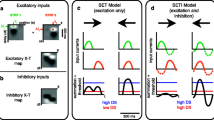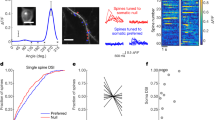Abstract
It is still an open question as to whether, and how, direction-selective neuronal responses in primary visual cortex are generated by feedforward thalamocortical or recurrent intracortical connections, or a combination of both. Here we present an investigation that concentrates on and, only for the sake of simplicity, restricts itself to intracortical circuits, in particular, with respect to the developmental aspects of direction selectivity through spike-timing-dependent synaptic plasticity. We show that directional responses can emerge in a recurrent network model of visual cortex with spiking neurons that integrate inputs mainly from a particular direction, thus giving rise to an asymmetrically shaped receptive field. A moving stimulus that enters the receptive field from this (preferred) direction will activate a neuron most strongly because of the increased number and/or strength of inputs from this direction and since delayed isotropic inhibition will neither overlap with, nor cancel excitation, as would be the case for other stimulus directions. It is demonstrated how direction-selective responses result from spatial asymmetries in the distribution of synaptic contacts or weights of inputs delivered to a neuron by slowly conducting intracortical axonal delay lines. By means of spike-timing-dependent synaptic plasticity with an asymmetric learning window this kind of coupling asymmetry develops naturally in a recurrent network of stochastically spiking neurons in a scenario where the neurons are activated by unidirectionally moving bar stimuli and even when only intrinsic spontaneous activity drives the learning process. We also present simulation results to show the ability of this model to produce direction preference maps similar to experimental findings
Similar content being viewed by others
References
Anderson JC., Binzegger T., Kahana O., Martin KAC., Segev I. (1999). Dendritic asymmetry cannot account for directional responses of neurons in visual cortex. Nature 2(9):820–824
Banton T., Bertenthal BI., Seaks J. (1999). Infants sensitivity to statistical distributions of motion direction and speed. Vision Research 39:3417–3430
Bartsch AP., van Hemmen JL. (2001). Combined hebbian development of geniculocortical and lateral connectivity in a model of primary visual cortex. Biological Cybernetics 84(1):41–55
Bi G., Poo M. (1998). Synaptic modifications in cultured hippocampal neurons: Dependence on spike timing, synaptic strength, and postsynaptic cell type. J Neurosci 18(24):10464–10472
Bringuier V., Chavane F., Glaeser L., Fregnac Y. (1999). Horizontal propagation of visual activity in the synaptic integration field of area 17 neurons. Science 283:695–699
Buchs N., Senn W. (2002). Spike-based synaptic plasticity and the emergence of direction selective simple cells: simulation results. J Comput Neurosci 13(3):167–186
Chapman B., Stryker MP., Bonhoeffer T. (1996). Development of orientation preference maps in ferret primary visual cortex. J Neurosci 16(20):6443–6453
Clifford CWG., Ibbotson MR. (2003). Fundamental mechanisms of visual motion detection: Models, cells and functions. Progress in Neurobiology 68:409–437
Crair MC., Gillespie DC., Stryker MP. (1998). The role of visual experience in the development of columns in cat visual cortex. Science 279(5350):566–570
Engert F., Tao HW., Zhang LI., Poo M. (2002). Moving visual stimuli rapidly induce direction sensitivity of developing tectal neurons. Nature 419:470–475
Feidler JC., Saul AB., Murthy A., Humphrey AL. (1997). Hebbian learning and the development of direction selectivity: the role of geniculate response timings. Network: Comput Neural Syst 8:195–214
Feldman DE. (2000). Timing-based LTP and LTD at vertical inputs to layer II/III pyramidal cells in rat barrel cortex. Neuron 27:45–56
Ferster D., Miller KD. (2000). Neural mechanisms of orientation selectivity in the visual cortex. Annual Reviews of Neurosci 23:441–471
Froemke RC., Dan Y. (2002). Spike-timing-dependent synaptic modification induced by natural spike trains. Nature 416:433–438
Fu Y., Shen Y., Gao H., Dan Y. (2004). Asymmetry in visual cortical circuits underlying motion-induced perceptual mislocalization. J Neurosci 24(9):2165–2171
Gerstner W., Kempter R., van Hemmen JL., Wagner H. (1996). A neuronal learning rule for sub-millisecond temporal coding. Nature 383(6595):76–81
Gerstner W., van Hemmen JL. (1994). Models of Neural Networks II. Coding and Information Processing in Neural Networks, Springer, pp. 1–93
Issa NP., Trachtenberg JT., Chapman B., Zahs KR., Stryker MP. (1999). The critical period for ocular dominance plasticity in the ferret’s visual cortex. J Neurosci 19(16):6965–6978
Katz LC., Shatz CJ. (1996). Synaptic activity and the construction of cortical circuits. Science 274:1133–1138
Kempter R., Gerstner W., van Hemmen JL. (1999) Spike-based compared to rate-based Hebbian learning. In: Adv. in Neural Information Processing Systems, vol 11
Livingstone MS. (1998). Mechanisms of direction selectivity in macaque V1. Neuron 20:509–526
Markram H., Lübke J., Sakmann B. (1997). Regulation of synaptic efficacy by coincidence of postsynaptic aps and epsps. Science 275(5297):213–215
Mehta MR., Wilson MA. (2000). From hippocampus to V1: Effect of LTP on spatiotemporal dynamics of receptive fields. Neurocomputing 32:905–911
Mineiro P., Zipser D. (1998). Analysis of direction selectivity arising from recurrent cortical interactions. Neural Computation 10:353–371
Ngezahayo A., Schachner M., Artola A. (2000). Synaptic activity modulates the induction of bidirectional synaptic changes in adult mouse hippocampus. J Neurosci (7):2451–2458
Noll J., Wenisch OG., van Hemmen JL. (2002). Simulation of Neuronal Map Formation in the Primary Visual Cortex. High Performance Computing in Science and Engineering. Springer, pp 135–142
Rao RP., Sejnowski TJ. (2001). Predictive learning of temporal sequences in recurrent neocortical circuits. Novartis Found Symposium 239:208–229
Roerig B., Chen B., Kao JP. (2003). Different inhibitory synaptic input patterns in exc. and inhib layer 4 neurons of ferret visual cortex. Cereb Cortex 13(4):350–363
Roerig B., Kao J. (1999). Organization of intracortical circuits in relation to direction preference maps in ferret visual cortex. J Neuronsci 24(19):RC44
Sabatini SP., Solari F. (1999). An architectural hypothesis for direction selectivity in the visual cortex: The role of spatially asymmetric intracortical inhibition. Biological Cybernetics 80(3):171–183
Schütt S., Bonhoeffer T., Hübener M. (2001). Pairing-induced changes of orientation maps in cat visual cortex. Neuron 32:325–337
Senn W., Schneider M., Ruf B. (2002). Activity-dependent development of axonal and dendritic delays, or, why synaptic transmission should be unreliable. Neural Computation 14:583–619
Shmuel A., Grinvald A. (1996). Functional organization for direction of motion and its relationship to orientation maps in cat area 18. J Neurosci 16(21):6945–6964
Shon AP., Rao RPN., Sejnowski TJ. (2004). Motion detection and prediction through spike-timing dependent plasticity. Network: Comput Neural Syst 15:179–198
Suarez H., Koch C., Douglas R. (1995). Modeling direction selectivity of simple cells in striate visual cortex within the framework of the canonical microcircuit. J Neurosci 15(10):6700–6719
Sur M., Leamey CA. (2001). Development and plasticity of cortical areas and networks. Nature Reviews—Neuroscience. 2(4): 251–262
Weliky M., Bosking WH., Fitzpatrick D. (1996). A systematic map of direction preference in primary visual cortex. Nature 379(6567):725–728
Wimbauer S., Wenisch OG., Miller KD., van Hemmen JL. (1997). Development of spatiotemporal receptive fields of simple cells: I. model formulation. Biological Cybernetics 77:453–461
Yao H., Shen Y., Dan Y. (2004). Intracortical mechanism of stimulus-timing-dependent plasticity in visual cortical orientation tuning. In: Proceeding of the National Academy of Sciences 101:35081–5086
Zhang LI., Tao HW., Holt CE., Harris WA., Poo M-M. (1998). A critical window for cooperation and competition among developing retinotectal synapses. Nature 395:37–44
Author information
Authors and Affiliations
Corresponding author
Rights and permissions
About this article
Cite this article
Wenisch, O.G., Noll, J. & Hemmen, J.L.v. Spontaneously emerging direction selectivity maps in visual cortex through STDP. Biol Cybern 93, 239–247 (2005). https://doi.org/10.1007/s00422-005-0006-z
Received:
Accepted:
Published:
Issue Date:
DOI: https://doi.org/10.1007/s00422-005-0006-z




